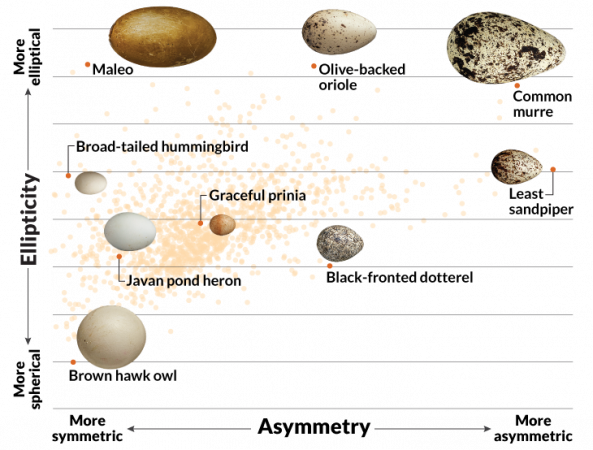Evolving for flight may have changed the shapes of bird eggs
Scientists might have cracked the mystery of why eggs look so different

Bird eggs come in many different shapes, sizes and colors. A new study shows a link between how birds fly and the shape of the eggs they lay.
HARVARD MUSEUM OF COMPARATIVE ZOOLOGY
Bird eggs come in many shapes, from the brown hawk owl’s almost perfectly round egg to the raindrop-shaped egg of the least sandpiper. The reason for all these different egg shapes has long puzzled biologists. New research suggests an answer. As birds evolved for different types of flight, changes to their bodies may have helped shape their eggs. Stronger fliers tend to lay eggs that are more stretched out, for instance.
Eggs all have the same job: to protect and feed chicks. So the reason they come in so many shapes “was a question that we found intriguing,” says Mary Caswell Stoddard. She’s an evolutionary biologist at Princeton University in New Jersey and one of the study’s authors.
Previous studies had suggested many ways the different shapes might help birds. Maybe cone-shaped eggs are less likely to roll out of the nests of cliff-dwelling birds. Or perfectly round eggs might resist damage in the nest. But no one had tested these guesses across a wide range of birds.
So Stoddard and her team decided to take a stable at it. They analyzed almost 50,000 eggs. These represented1,400 species, or about 14 percent of all the bird species. The researchers reduced each egg to its two-dimensional silhouette. Then they used an algorithm to describe each egg using two variables. One was how elliptical or spherical the egg is — is its silhouette more of an oval, or a circle? The other variable was asymmetry — is the egg pointier on one end than the other?
Story continues below image.

Next, the researchers looked at how these two traits vary across the bird family tree. One pattern jumped out. Species that are stronger fliers tend to lay more elliptical or asymmetrical eggs. (The researchers used wing shape to measure how strong a flier each bird was.) Stoddard’s group shared its results June 23 in Science.
Study coauthor L. Mahadevan is a mathematician and biologist at Harvard University in Cambridge, Mass. He cautions that the data show only that egg shape and flying strength are linked — not why.
But Stoddard’s group has one idea.
As birds evolved to fly, their bodies adapted by becoming more streamlined. Their reproductive tracts might have become more streamlined and narrow too. That would have limited the width of an egg that a female could lay. But eggs provide nutrition for growing chicks, so shrinking eggs too much could harm developing birds. Long, stretched-out eggs might have been a compromise, Stoddard says. That shape could give eggs more volume without increasing their width. Asymmetry can increase egg volume in a similar way.
It’s hard to prove that adapting to flight changed egg shapes long ago. “Of course we can’t replay the whole tape of life again,” says Claire Spottiswoode. She’s a zoologist at the University of Cambridge in England. Spottiswoode wrote a commentary that was published in Science along with the study. Still, Spottiswoode thinks the evidence is compelling. “It’s a very plausible argument,” she says.
Santiago Claramunt isn’t convinced that flight adaptations drove the evolution of egg shapes. He’s the associate curator of ornithology in Canada at the Royal Ontario Museum in Toronto. Claramunt says that how streamlined a bird is has more to do with its feathers than the shape of its body.
“High-performing fliers can have rounded, bulky bodies,” he argues, which wouldn’t give elongated eggs an advantage. He says frigate birds and swifts are good examples. Both of these birds make long-distance flights but have fairly broad bodies. “There’s certainly more going on there,” Claramunt says.
Some groups of birds showed a much stronger link between flying and egg shape than did others. And certain factors — such as where birds lay their eggs, or how many they lay at once — weren’t srongly related to egg shape across all birds. Still, they might be important within certain branches of the bird family tree.







